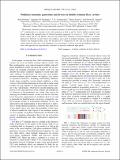| dc.contributor.author | Hashemi, Hila | |
| dc.contributor.author | Rodriguez, Alejandro W. | |
| dc.contributor.author | Joannopoulos, John D. | |
| dc.contributor.author | Soljacic, Marin | |
| dc.contributor.author | Johnson, Steven G. | |
| dc.date.accessioned | 2010-02-11T21:24:54Z | |
| dc.date.available | 2010-02-11T21:24:54Z | |
| dc.date.issued | 2009-01 | |
| dc.date.submitted | 2008-10 | |
| dc.identifier.issn | 1094-1622 | |
| dc.identifier.issn | 1050-2947 | |
| dc.identifier.uri | http://hdl.handle.net/1721.1/51730 | |
| dc.description.abstract | We describe a theoretical analysis of the nonlinear dynamics of third-harmonic generation (ω→3ω) via Kerr (χ(3)) nonlinearities in a resonant cavity with resonances at both ω and 3ω. Such a doubly resonant cavity greatly reduces the required power for efficient harmonic generation, by a factor of ∼V∕Q(2), where V is the modal volume and Q is the lifetime, and can even exhibit 100% harmonic conversion efficiency at a critical input power. However, we show that it also exhibits a rich variety of nonlinear dynamics, such as multistable solutions and long-period limit cycles. We describe how to compensate for self- and cross-phase modulation (which otherwise shifts the cavity frequencies out of resonance), and how to excite the different stable solutions (and especially the high-efficiency solutions) by specially modulated input pulses. | en |
| dc.description.sponsorship | Department of Energy Computational Science Fellowship | en |
| dc.description.sponsorship | Army Research Office, ISN | en |
| dc.language.iso | en_US | |
| dc.publisher | American Physical Society | en |
| dc.relation.isversionof | http://dx.doi.org/10.1103/PhysRevA.79.013812 | en |
| dc.rights | Article is made available in accordance with the publisher's policy and may be subject to US copyright law. Please refer to the publisher's site for terms of use. | en |
| dc.source | APS | en |
| dc.title | Nonlinear harmonic generation and devices in doubly resonant Kerr cavities | en |
| dc.type | Article | en |
| dc.identifier.citation | Hashemi, Hila et al. “Nonlinear harmonic generation and devices in doubly resonant Kerr cavities.” Physical Review A 79.1 (2009): 013812. (C)2010 The American Physical Society. | en |
| dc.contributor.department | Massachusetts Institute of Technology. Institute for Soldier Nanotechnologies | en_US |
| dc.contributor.department | Massachusetts Institute of Technology. Department of Mathematics | en_US |
| dc.contributor.department | Massachusetts Institute of Technology. Department of Physics | en_US |
| dc.contributor.approver | Joannopoulos, John D. | |
| dc.contributor.mitauthor | Hashemi, Hila | |
| dc.contributor.mitauthor | Rodriguez, Alejandro W. | |
| dc.contributor.mitauthor | Joannopoulos, John D. | |
| dc.contributor.mitauthor | Soljacic, Marin | |
| dc.contributor.mitauthor | Johnson, Steven G. | |
| dc.relation.journal | Physical Review A | en |
| dc.eprint.version | Final published version | en |
| dc.type.uri | http://purl.org/eprint/type/JournalArticle | en |
| eprint.status | http://purl.org/eprint/status/PeerReviewed | en |
| eprint.grantNumber | DE-FG02- 97ER25308 | en |
| eprint.grantNumber | W911NF-07-D-0004 | en |
| dspace.orderedauthors | Hashemi, Hila; Rodriguez, Alejandro; Joannopoulos, J.; Soljačić, Marin; Johnson, Steven | en |
| dc.identifier.orcid | https://orcid.org/0000-0001-7327-4967 | |
| dc.identifier.orcid | https://orcid.org/0000-0002-7184-5831 | |
| dc.identifier.orcid | https://orcid.org/0000-0002-7244-3682 | |
| mit.license | PUBLISHER_POLICY | en |
| mit.metadata.status | Complete | |
